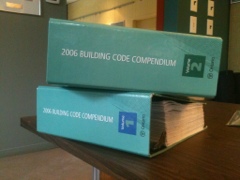I can just image how the conversation would go after that introduction...Farmer; "why do I need to put a sprinkler system, fire alarm, washrooms, in my building? its just a barn! With all this red tape and regulation your going to put me out of business!!" Building Code; "The requirements are a health and safety concern for the general public who might be coming to visit your farm. I know it's just a barn, but when the public arrive, its more than that. I am just trying to look out for the well-being of the general public." If your having a rough day with the building code, check out this for a laugh. I am continuing to encounter the grey area that is in between the Agricultural Building Code that governs farm and low occupancy buildings and the Ontario Building Code, that governs all other buildings types as I look at various rural projects. As farmers bring the general public out to the farm with agritourism and on-farm markets, this grey area is going to become more and more contentious. To give you an example, there was a farm in my area that was holding weddings in the old bank barn (a beautiful setting and probably quite lucrative business). But when the township discovered this, they sent the building inspector over. As you can probably imagine there were a lot of deficiencies. So much so, that they were unable to meet these needs and they closed their doors. In another instance a friend of mine visited a winery to see if they could hold their wedding at the location. They viewed the facilities and it was quite clear that the barn was not originally designed to be a wedding hall, and did not have the necessary requirements (ie, washrooms) to meet their needs (including a lack of aesthetics), let alone building code requirements (ie. number of exits from the building). As an architect I am very familiar with the Ontario Building Code, it dictates almost everything I can do with a building and it is designed to protect the health and safety of the general public. The Agricultural code, however is more concerned with the general good practices building practices, nutrient management, and building structural integrity. As a farmer if you are considering bringing the public to your facility you may encounter some of the following issues; 1. Washroom count - based on your occupancy use(store, or wedding hall, or office space) and your occupancy count (number of people), the building code dictates how many washrooms you require. Of those washrooms it is likely that a number of them will be required to be barrier free (or handicapped accessible), see number 7 below. Using the occupancy load recommendations, posting a maximum occupancy, or designing a specific load the architect can keep the washroom count reasonable and suited to your business and budget requirements. 2. Your project should fit into on of these major classifications Group A-assembly, Group B-Care, Group C-----, Group D-mercantile, Group E-business and personal services, Group F-Industrial, and further into the subdivisions. So if you want to host weddings at your farm, then you need to be in the Group A-assembly use. But if you just want to have a store or spa service, then you classify as Group D or E. The occupancy of your building will determine requirements such as number of washrooms, sprinkler systems, fire alarm systems, etc. 3. Once the occupancy type is determined using the defined groups above in the building code, then your building is sub-classified and must meet the requirements of a certain sub-category that is mostly based 3 factors;
- area of the building
- sprinklered or not
- what it built out of (combustible or non-combustible materials)
- cover and fire rate your wood structure, this often involves 2 layer of type 'X' drywall (thicker and more expensive than regular drywall), or
- Change your building structure into a non-combutible material. This is either steel, concrete, masonry, and heavy timber. Note that steel is generally non-combustible but it does melt, so it does not have a fire rating if fire ratings are required.
